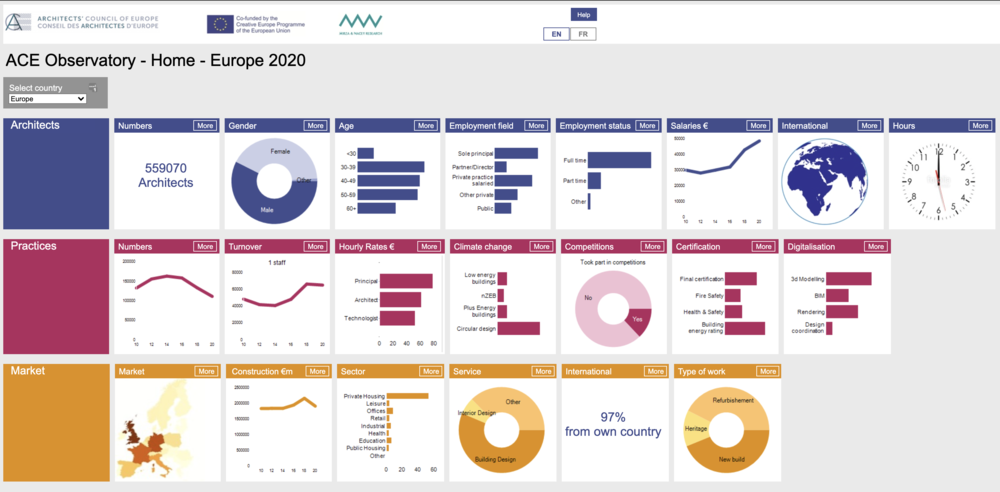
- News
- Publications
- Press releases
- Links
- Contact
- Members area
The Sector Study is a biennial survey commissioned by the Architects’ Council of Europe (ACE) and co-funded by the Creative Europe Programme of the European Union, that collects and analyses statistical, sociological and economic data on European architects, the architectural market and architectural practices. Based on responses from 25.600 architects in 26 European countries, the 2020 edition of the Study has been enriched with new research areas, making it, without doubt, the most comprehensive study on the architectural profession in Europe and an essential reference tool for all those interested in the architectural profession and the built environment.
The Covid-19 crisis is the cognitive filter through which this year’s survey will inevitably be reviewed. The social and economical costs, the disruption and the continuing uncertainty - each impacts on this year’s results. Covid-19 has affected the way architects work, where they work and indeed whether they work at all. The pandemic has disrupted employment for a significant number of private practice staff. Future confidence has diminished, as more architects expect workload to fall in the next 12 months. However, architects are well placed for recovery.
The research shows that while the number of architects had grown by 24% between 2008 and 2018, it is unchanged since then. Architects contribute EUR 17 billion to Europe’s economy. Sustainable architecture emerges as a growing trend with 57% of architects “frequently” designing low-energy buildings.
The value of the architectural market continues to increase, rising by 4% since 2018. Private housing remains the most important sector for architects; almost 9 out of 10 architectural practices have undertaken some housing design work in the past year and the sector generates 54% of average practice turnover.
The profession is becoming more balanced: the proportion of female architects has increased from 31% in 2010 to 42%. The gender pay gap has reduced from 25% in 2018 to 21% in 2020. The pay gap remains, however. On the other side, we can underline the International perspective : the study shows that more than one in three architects has studied in another country.
ACE President georg pendl points out: "I recall that such studies are a basic starting point for an organisation aspiring to represent the interests of the architects. First of all, we need to know who we are, then we can draw our conclusions to inform our next steps. Again, as in the previous years, we see the profession - by huge a majority - to be made up of micro- and small enterprises. But this doesn’t mean that such offices are unable to design relatively large projects: a fact that is not so well known, but actually the reality. We need to underline this, especially with regard to public procurement issues, where we face a tendency to exclude smaller entities."
One of the report’s authors, Aziz Mirza, says: “This year’s Sector Study findings are bisected by the Covid-19 crisis. Some statistics – practice turnover, market size, workloads – show the profession was continuing to grow before the pandemic struck. Other statistics show how architects are starting to be hit by the present crisis – such as the fall in full-time working and rising unemployment. While the profession cannot be immune from the economic effects of the pandemic, the Sector Study shows that Europe’s architects are enthusiastic adopters of digitalisation tools which makes them well prepared for the recovery, when it comes.”
Photo credits for front cover: Olympic Stadium Helsinki refurbishment, Finland Architect: K2S and NRT Photograph: Paula Huotelin
FIND ALL THE DATA ON THE ACE OBSERVATORY
The ACE 2020 Sector Study is also available on the ACE Observatory a new web platform dedicated to the architectural profession. The ACE Observatory is designed to complement the report, providing extra depth. It has been designed for use by Member Organisations, individual architects and anyone wanting to research the profession.

